|
Is it too much to suggest that we may recognize... the beauty and fittingness of an environment created by an assembly of creatures? — James Lovelock (1)
Regardless of the paradigm we use to explain it, life on Earth has evolved from prokaryotes, to single-celled eukaryotes, to multicelled animals and plants, to animals and plants with highly specialized organs and systems. This truth we can all accept.
The environment of Earth has also evolved. Earth has cooled, the temperature has stabilized, and the composition of the atmosphere has completely changed. Under the current paradigm, the two parallel evolutions, life and its environment, affect each other, but not in any coordinated way. Life consumes resources and discharges waste products; these processes alter the environment. As the environment changes, it presents new challenges to life. So far, luckily, life has been able to meet the challenges. That's the orthodoxy.
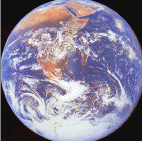
The Oxygen Atmosphere
The most important change in Earth's environment since life began is the buildup of free oxygen in the air. Before life became established on Earth, the air contained no free oxygen. Today, the atmosphere is 21 percent oxygen. Although small amounts of oxygen were present very soon after life appeared, the significant buildup probably began about 2.5 billion years ago. By the time of the Cambrian Explosion, maybe 540 million years ago, the oxygen content had to be approximately as high as it is today.
There is evidence that the beginning of the oxygen buildup coincides with the appearance of the first eukaryotic cells. Most bacteria don't require oxygen, and many are poisoned by oxygen. All eukaryotic cells require oxygen for their more complicated and more efficient metabolism. Furthermore, there has to be oxygen for there to be ozone. Ozone shields the surface of Earth from damaging ultraviolet rays. Only with such shielding can life come out from under water or underground and begin to live on the surface (2):
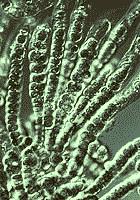 cyanobacteria by Susan M. Barns cyanobacteria by Susan M. Barns |
It is widely believed that 2000 million years ago the cyanobacteria—oxygen-eliminating photosynthetic prokaryotes that used to be called blue-green algae—effected one of the greatest changes this planet has ever known: the increase in concentration of atmospheric oxygen from far less than 1% to about 20%. Without this concentration of oxygen, people and other animals never would have evolved.
The orthodox understanding of this event is that when the oxygen began to accumulate, it constituted a wholesale pollution of the environment, a "holocaust" upon the bacteria of Earth (3, 4). Chance mutations in the genes of some bacteria enabled them to endure the oxygen atmosphere and rescued them. At the same time a fortunate symbiosis between bacteria and the formerly free-living mitochondria enabled eukaryotes to evolve in response to the crisis. Oxygen-based metabolism came into being. The environment changed and life randomly followed. True, the oxygen-based system of metabolism in animals and plants is excellent, but in another environment, another metabolic system might have evolved, according to the Darwinian paradigm.

James Lovelock
English inventor, atmospheric chemist, winner of the 1996 Volvo Environment Prize and the 1997 Asahi Glass Foundation Blue Planet Prize, James Lovelock thinks there may be a closer connection, a coordination between the evolution of life and the evolution of the environment. He calls his theory Gaia (from the Greek goddess of Earth). The theory, described in his 1979 book Gaia (5), can be paraphrased in different ways. In the preface to Gaia, Lovelock writes, "...the biosphere is a self-regulating entity with the capacity to keep our planet healthy by controlling the chemical and physical environment." Others have described the theory as the idea that Earth itself acts like a single organism.
Lovelock believes, for example, that Gaia is at work to keep the oxygen content of the atmosphere high and within the range that all oxygen-breathing animals require. The atmospheres of our two nearest neighbors, Venus and Mars, contain 0.00 percent and 0.13 percent, respectively, of free oxygen. Without life to keep supplying it, Earth soon wouldn't have any either.
Lovelock believes that life regulates the surface temperature of Earth, too. He says the average surface temperature of Earth has remained within a narrow range — between 10 and 20° C — for over three billion years. Other research shows that the range could be wider (6), but the constancy of Earth's surface temperature since life became established is still remarkable. During that time the sun's output has increased by thirty or forty percent. How has this stability of Earth's temperature been maintained? Even ignoring the long-term trend of the sun, wouldn't the temperature vary more than that? How stable is the temperature on our neighboring planets?
In March 1995, the Hubble Space Telescope "weather center" issued a report containing the following: "The higher temperatures and global dust storms on Mars in the 1970s have ended. The skies are now clear and 36 [Fahrenheit] degrees colder, on average, with morning haze and lingering clouds near the volcanoes" (8). Two years later, when the Hubble telescope was again aimed at Mars, even more dramatic changes were noticed (9):
Abrupt swings that would devastate civilization if they occurred on Earth are routine on Mars, where the global climate can veer from relatively hot, dusty weather to very cold and cloudy within a matter of days.... On Earth, a change in global average temperature of only a degree or so over decades has raised concerns about global warming. On Mars... the temperature can swing by 80 degrees Fahrenheit wthin days.
These reports give strong evidence that a mechanism to keep Earth's surface temperature steady is needed. The fact that Earth's temperature is steady means that the mechanism — whatever it is — is working.
Salinity of the Sea
Lovelock says another example of Gaia in operation is the regulation of the saltiness of seawater. Seawater is about 3.4 percent salt by weight, and has probably been under 4 percent for as far back as we have data. If it ever rose to over 6 percent, all the life in the sea (except maybe for some archaebacteria) would be killed. Lovelock calculated that the entire salt content of the oceans is replaced every sixty million years by material carried from the continents in rivers and by material vented from below the ocean floor where it is spreading (10). Some other process must constantly remove the salt or else it would keep accumulating in seawater. This accumulation happens in seas where the removal process is not available, such as the Great Salt Lake and the Dead Sea.
The process Lovelock likes for preventing excess salt accumulation in the ocean is the evaporation of seawater in shallow lagoons and salt marshes. There seawater is evaporated for recycling, as rain, into fresh water. The salt precipitates out and is buried under layers of sediment. Thus, the shallow lagoons and salt marshes cleanse the oceans as our own kidneys remove impurities from our blood. Lagoons are created by coral reefs, huge biologically created structures. Lagoons gradually fill in, get shallower, and become salt marshes. So coral reefs, which create the necessary lagoons, would have an essential, unexpected Gaian purpose (11).
The Burial of Carbon
Another Gaian process is the burial of carbon in sedimentary rocks. "A constant rain of carbonate bearing shells sinks toward the ocean floor, where it ultimately forms beds of chalk or limestone rock and thus prevents the stagnation of carbon dioxide in the upper layers of the sea" (12). This process in turn has reduced the carbon dioxide content of the atmosphere from levels seen on Venus and Mars to the low ppm levels that have prevented runaway greenhouse warming. It may even help to bring about Earth's plate tectonics. Among the solar planets, only Earth apparently has plate tectonics (13). This very slow turning of Earth's crust may also prove important for life (14, 15).
The Teleological Aspect of Gaia
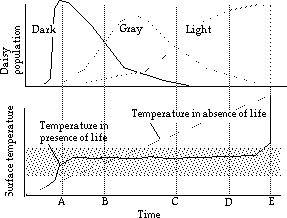 Graph with three kinds of daisies (from Lawrence University) |
Lovelock sees many processes that convert and stabilize the environment as evidence of Gaia at work. But operating with a Darwinian philosophy, he has a hard time explaining why life ever undertakes to manipulate the environment in the first place. His theory has been called teleological by many critics. In his newer version of Gaia, Lovelock avoids saying that life regulates anything. He writes rather, that "life and the material environment evolved tightly coupled together as a single entity. Self regulation is then an emergent property of the system" (16).
Partly in response to the accusation of teleology, Lovelock wrote a second book about Gaia entitled The Ages of Gaia, published in 1988 (17). In this work he discusses a new metaphor, "Daisyworld," within which two kinds of daisies unwittingly cooperate to keep the temperature of the planet more constant than it would otherwise be. Lovelock's Daisyworld by itself seems inadequate to overcome the teleological appearance of a big dumb spontaneous Gaia that somehow knows which strings to pull.
This doesn't mean that Gaia is a mistaken idea. But it is hard to believe that Gaian processes can evolve by chance. The trials would take too long. For example, one trial of a mechanism for regulating the saltiness of seawater would take at least sixty million years. If Gaia didn't luck upon the right system for that problem on the first try, things would soon become grim.
Gaia makes much more sense if the stabilizing feedback loops were not blindly discovered, but were already available when the need for them arose. This would mean, for example, that the genes for cyanobacteria, for coral, and for animals with carbonate shells were already available when they were needed. Thus, the processes of oxygen accumulation, desalinization of seawater, and burial of carbon would have begun on this planet without delay. In cosmic ancestry, the Gaian capability of planetary life depends on genetic programming that already exists.
What'sNEW
 "An Agnostic Biosignature Based on Modeling Panspermia and Terraformation," by Harrison B. Smith and Lana Sinapayen, https://arxiv.org/abs/2403.14195, 21 Mar 2024; and commentary by Evan Gough, Universe Today.
The authors make an interesting point regarding panspermia and terraforming. They're both things that life already does.... The researchers are interested in intentional terraforming by space-faring civilizations, but at least they are aware of natural terraforming by Gaian processes. "An Agnostic Biosignature Based on Modeling Panspermia and Terraformation," by Harrison B. Smith and Lana Sinapayen, https://arxiv.org/abs/2403.14195, 21 Mar 2024; and commentary by Evan Gough, Universe Today.
The authors make an interesting point regarding panspermia and terraforming. They're both things that life already does.... The researchers are interested in intentional terraforming by space-faring civilizations, but at least they are aware of natural terraforming by Gaian processes.
 "Oxygen isotope ensemble reveals Earth's seawater, temperature, and carbon cycle history," by Terry Isson and Sofia Rauzi, Science, 08 Feb 2024. "Oxygen isotope ensemble reveals Earth's seawater, temperature, and carbon cycle history," by Terry Isson and Sofia Rauzi, Science, 08 Feb 2024.
 "Characteristic processes of human evolution caused the Anthropocene and may obstruct its global solutions," by Timothy M. Waring, Zachary T. Wood and Eörs Szathmáry, Phil. Trans. R. Soc. B, 13 Nov 2023. "Characteristic processes of human evolution caused the Anthropocene and may obstruct its global solutions," by Timothy M. Waring, Zachary T. Wood and Eörs Szathmáry, Phil. Trans. R. Soc. B, 13 Nov 2023.
 "First exploration of the runaway greenhouse transition with a 3D General Circulation Model," by Guillaume Chaverot et al., Astronomy & Astrophysics, Dec 2023. "First exploration of the runaway greenhouse transition with a 3D General Circulation Model," by Guillaume Chaverot et al., Astronomy & Astrophysics, Dec 2023.
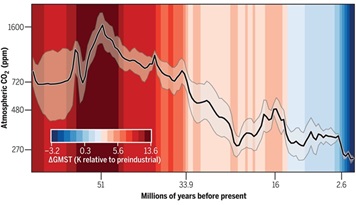
 "Toward a Cenozoic history of atmospheric CO2," Science, 08 Dec 2023 (graph, right).
Reconstructions of 50 million years of past climate are telling a consistent story. "Toward a Cenozoic history of atmospheric CO2," Science, 08 Dec 2023 (graph, right).
Reconstructions of 50 million years of past climate are telling a consistent story.
 "Evolution of the polycrisis: Anthropocene traps that challenge global sustainability," by Peter Søgaard Jørgensen et al., Phil. Trans. R. Soc. B; and commentary: Stockholm Resilience Center (+PhysOrg.com), 13 Nov 2023. "Evolution of the polycrisis: Anthropocene traps that challenge global sustainability," by Peter Søgaard Jørgensen et al., Phil. Trans. R. Soc. B; and commentary: Stockholm Resilience Center (+PhysOrg.com), 13 Nov 2023.
 11 Aug 2023: Major "tipping points".... 11 Aug 2023: Major "tipping points"....
 "Land Fraction Diversity on Earth-like Planets and Implications for Their Habitability" [link], by Dennis Höning and Tilman Spohn, International Journal of Astrobiology, 31 Mar 2023. "Land Fraction Diversity on Earth-like Planets and Implications for Their Habitability" [link], by Dennis Höning and Tilman Spohn, International Journal of Astrobiology, 31 Mar 2023.
 "Intelligence as a planetary scale process" [link], by Adam Frank, David Grinspoon and Sara Walker, International Journal of Astrobiology, 07 Feb 2022.
...the basic principles of Gaia Theory, effectively repackaged as 'Earth Systems Science', now represent the cornerstone of modern approaches to Earth's evolutionary history. What Earth Systems Science took from Gaia Theory was its recognition of the biosphere as a principal driver of planetary evolution, as well as the profound role of collective microbial activity in shaping critical biospheric feedbacks. "Intelligence as a planetary scale process" [link], by Adam Frank, David Grinspoon and Sara Walker, International Journal of Astrobiology, 07 Feb 2022.
...the basic principles of Gaia Theory, effectively repackaged as 'Earth Systems Science', now represent the cornerstone of modern approaches to Earth's evolutionary history. What Earth Systems Science took from Gaia Theory was its recognition of the biosphere as a principal driver of planetary evolution, as well as the profound role of collective microbial activity in shaping critical biospheric feedbacks.
 "A safe operating space for humanity" by J. Rockström, W. Steffen, K. Noone et al., Nature, 23 Sep 2009. "A safe operating space for humanity" by J. Rockström, W. Steffen, K. Noone et al., Nature, 23 Sep 2009.
 "Presence or absence of stabilizing Earth system feedbacks on different time scales" by Constantin W. Arnscheidt and Daniel H. Rothman, Science Advances, 16 Nov 2022. "Presence or absence of stabilizing Earth system feedbacks on different time scales" by Constantin W. Arnscheidt and Daniel H. Rothman, Science Advances, 16 Nov 2022.
 "James Lovelock (1919–2022): Father of Earth system science" by Timothy M. Lenton, Science, 25 Aug 2022. "James Lovelock (1919–2022): Father of Earth system science" by Timothy M. Lenton, Science, 25 Aug 2022.
 "James E. Lovelock (1919–2022)," by John Gribbin, Nature, 03 Aug 2022. "James E. Lovelock (1919–2022)," by John Gribbin, Nature, 03 Aug 2022.
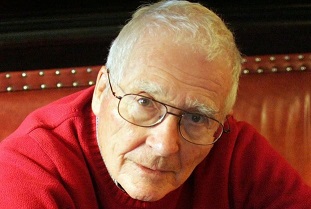
 28 Jul 2022: James Ephraim Lovelock died, 26 July 2022. 28 Jul 2022: James Ephraim Lovelock died, 26 July 2022.
 "Eukaryogenesis and oxygen in Earth history" by Daniel B. Mills et al., Nature, 21 Apr 2022.
...mitochondria-bearing eukaryotes are consistently dated ...during an interval of pervasive deep-sea anoxia and variable surface-water oxygenation. "Eukaryogenesis and oxygen in Earth history" by Daniel B. Mills et al., Nature, 21 Apr 2022.
...mitochondria-bearing eukaryotes are consistently dated ...during an interval of pervasive deep-sea anoxia and variable surface-water oxygenation.
 01 Apr 2022: Did Earth's solid iron inner core enable life's Cambrian Explosion? 01 Apr 2022: Did Earth's solid iron inner core enable life's Cambrian Explosion?
 "Earth's oldest land ecosystem spotted in South African rock cores" by Paul Voosen, Science, 13 Apr 2022. "Earth's oldest land ecosystem spotted in South African rock cores" by Paul Voosen, Science, 13 Apr 2022.
 16 Mar 2022: ...SAR202 bacteria likely acquired BVMO around the time of the GOE via a horizontal gene transfer event.... 16 Mar 2022: ...SAR202 bacteria likely acquired BVMO around the time of the GOE via a horizontal gene transfer event....
 "Intelligence as a planetary scale process" by Adam Frank et al., International Journal of Astrobiology, 07 Feb 2022. "Intelligence as a planetary scale process" by Adam Frank et al., International Journal of Astrobiology, 07 Feb 2022.
 28 Jan 2022: Faint-Sun Paradox considered. 28 Jan 2022: Faint-Sun Paradox considered.
 13 Jan 2022: Falter: Has the Human Game Begun to Play Itself Out? by Bill McKibben, 2019. 13 Jan 2022: Falter: Has the Human Game Begun to Play Itself Out? by Bill McKibben, 2019.
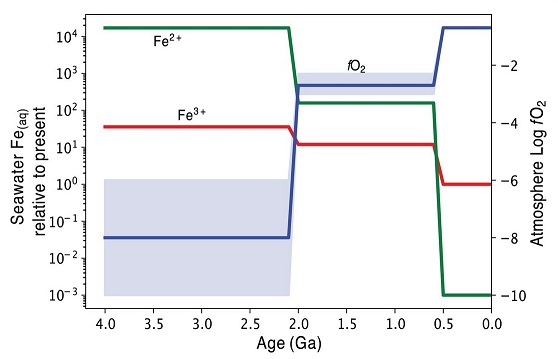
 "Temporal variation of planetary iron as a driver of evolution" by Jon Wade et al. [see right], doi:10.1073/pnas.2109865118, PNAS, 21 Dec 2021. "Temporal variation of planetary iron as a driver of evolution" by Jon Wade et al. [see right], doi:10.1073/pnas.2109865118, PNAS, 21 Dec 2021.
 Are Planets with Continuous Surface Habitability Rare? by Alex Tolley, intro by Paul Gilster, Centauri Dreams, 28 May, and more commentary from Newswise, 24 Jun 2021, re: Are Planets with Continuous Surface Habitability Rare? by Alex Tolley, intro by Paul Gilster, Centauri Dreams, 28 May, and more commentary from Newswise, 24 Jun 2021, re:
 "Efficiency of the oxygenic photosynthesis on Earth-like planets in the habitable zone" by Giovanni Covone et al., doi:10.1093/mnras/stab1357, Monthly Not. RAS, 19 May 2021. "Efficiency of the oxygenic photosynthesis on Earth-like planets in the habitable zone" by Giovanni Covone et al., doi:10.1093/mnras/stab1357, Monthly Not. RAS, 19 May 2021.
 Nickel isotopes link Siberian Traps aerosol particles to the end-Permian mass extinction by Menghan Li et al., Nature Communications, 01 Apr 2021. Nickel isotopes link Siberian Traps aerosol particles to the end-Permian mass extinction by Menghan Li et al., Nature Communications, 01 Apr 2021.
 07 Mar 2021: ... if we know the amount of iron present in a planet's mantle.... 07 Mar 2021: ... if we know the amount of iron present in a planet's mantle....
 Long-term drying of Mars by sequestration of ocean-scale volumes of water in the crust by E. L. Scheller et al., doi:10.1126/science.abc7717, Science, 02 Apr 2021. Long-term drying of Mars by sequestration of ocean-scale volumes of water in the crust by E. L. Scheller et al., doi:10.1126/science.abc7717, Science, 02 Apr 2021.
 A 200-million-year delay in permanent atmospheric oxygenation by Poulton, S.W., Bekker, A., Cumming, V.M. et al., doi:10.1038/s41586-021-03393-7, Nature, 29 Mar 2021. A 200-million-year delay in permanent atmospheric oxygenation by Poulton, S.W., Bekker, A., Cumming, V.M. et al., doi:10.1038/s41586-021-03393-7, Nature, 29 Mar 2021.
 07 Mar 2021: Genes allowing oxygen metabolism were present among bacteria 3.1 billion years ago.... 07 Mar 2021: Genes allowing oxygen metabolism were present among bacteria 3.1 billion years ago....
 Chance played a role in determining whether Earth stayed habitable by Toby Tyrrell, doi:10.1038/s43247-020-00057-8, Commun Earth Environ, 11 Dec 2020. Chance played a role in determining whether Earth stayed habitable by Toby Tyrrell, doi:10.1038/s43247-020-00057-8, Commun Earth Environ, 11 Dec 2020.
 Dust storms on Mars propel water's escape to space by Paul Voosen, Science, 13 Nov 2020. Dust storms on Mars propel water's escape to space by Paul Voosen, Science, 13 Nov 2020.
 Earth may have been a 'water world' 3bn years ago... by Ian Sample, The Guardian, 02 Mar 2020; re: Earth may have been a 'water world' 3bn years ago... by Ian Sample, The Guardian, 02 Mar 2020; re:
 Limited Archaean continental emergence reflected in an early Archaean 18O-enriched ocean by Benjamin W. Johnson and Boswell A. Wing, Nature Geoscience, 02 Mar 2020. Limited Archaean continental emergence reflected in an early Archaean 18O-enriched ocean by Benjamin W. Johnson and Boswell A. Wing, Nature Geoscience, 02 Mar 2020.
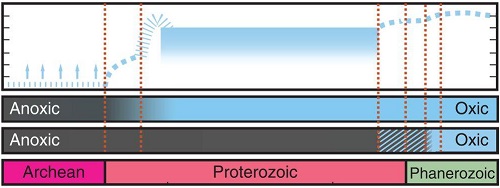
 Stepwise Earth oxygenation is an inherent property of global biogeochemical cycling by Lewis J. Alcott et al., doi:10.1126/science.aax6459, Science, 13 Dec 2019. (Click graph to enlarge. Close to return.) Stepwise Earth oxygenation is an inherent property of global biogeochemical cycling by Lewis J. Alcott et al., doi:10.1126/science.aax6459, Science, 13 Dec 2019. (Click graph to enlarge. Close to return.)
 12 Dec 2019: The stability and resilience of our planet is in peril. 12 Dec 2019: The stability and resilience of our planet is in peril.
 Iron and Ice... by Max Lechte and Ashleigh Hood, University of Melbourne, 03 Dec 2019. ...meltwater from glaciers flowing into the oceans could have provided the vital oxygen needed for emerging complex life forms to survive Snowball Earth. Iron and Ice... by Max Lechte and Ashleigh Hood, University of Melbourne, 03 Dec 2019. ...meltwater from glaciers flowing into the oceans could have provided the vital oxygen needed for emerging complex life forms to survive Snowball Earth.
 19 Aug 2019: Paleologists have analyzed the Ordovician surge in biodiversity. 19 Aug 2019: Paleologists have analyzed the Ordovician surge in biodiversity.
 James Lovelock at 100: the Gaia saga continues by Tim Radford, Nature, 25 Jun 2019. James Lovelock at 100: the Gaia saga continues by Tim Radford, Nature, 25 Jun 2019.
 05 Jun 2019: Venus was Earthlike for most of its history, but "something went terribly wrong." 05 Jun 2019: Venus was Earthlike for most of its history, but "something went terribly wrong."
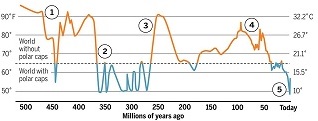
 01 Jun 2019: 500 million years ago, the average temperature of the ocean was 20°C higher than today. 01 Jun 2019: 500 million years ago, the average temperature of the ocean was 20°C higher than today.
 30 Apr 2019: ...microbes can impact major geological processes happening on Earth today. 30 Apr 2019: ...microbes can impact major geological processes happening on Earth today.
 16 Apr 2018: What signature would our civilization leave in the fossil record? 16 Apr 2018: What signature would our civilization leave in the fossil record?
 The big five mass extinctions by Viviane Richter, Cosmos, 2018. ...most had something to do with rapid climate change — palaeontologist Rolf Schmidt. The big five mass extinctions by Viviane Richter, Cosmos, 2018. ...most had something to do with rapid climate change — palaeontologist Rolf Schmidt.
 The geobiological nitrogen cycle: From microbes to the mantle, by AL Zerkle and S Mikhail, doi:10.1111/gbi.12228, Geobiology, May 2017. ...we discuss the current understanding ...for how the unique interaction of biological innovation, geodynamics, and mantle petrology has acted to regulate Earth's nitrogen cycle over geologic timescales. The geobiological nitrogen cycle: From microbes to the mantle, by AL Zerkle and S Mikhail, doi:10.1111/gbi.12228, Geobiology, May 2017. ...we discuss the current understanding ...for how the unique interaction of biological innovation, geodynamics, and mantle petrology has acted to regulate Earth's nitrogen cycle over geologic timescales.
 Atmospheric Evolution on Inhabited and Lifeless Worlds, by David C. Catling and James F. Kasting, ISBN-13: 978-0521844123, Cambridge University Press, 10 May, 2017. Atmospheric Evolution on Inhabited and Lifeless Worlds, by David C. Catling and James F. Kasting, ISBN-13: 978-0521844123, Cambridge University Press, 10 May, 2017.
 17 Mar 2018: If Earth's history is any guide, life in our galaxy will be mostly unicellular bacteria.... 17 Mar 2018: If Earth's history is any guide, life in our galaxy will be mostly unicellular bacteria....
 Causes of ice age intensification across the Mid-Pleistocene Transition, by Thomas B. Chalk, Mathis P. Hain et al., doi:10.1073/pnas.1702143114, PNAS, online 27 Nov 2017; and commentary:
Decline in atmospheric carbon dioxide key to ancient climate transition, University of Southampton, (+Newswise), 27 Nov 2017. Causes of ice age intensification across the Mid-Pleistocene Transition, by Thomas B. Chalk, Mathis P. Hain et al., doi:10.1073/pnas.1702143114, PNAS, online 27 Nov 2017; and commentary:
Decline in atmospheric carbon dioxide key to ancient climate transition, University of Southampton, (+Newswise), 27 Nov 2017.
 Biomass recycling and Earth's early phosphorus cycle, by Michael A. Kipp and Eva E. Stüeken, doi:10.1126/sciadv.aao4795, Science Advances, online 22 Nov 2017; and commentary:
Limited phosphorus recycling suppressed early Earth's biosphere by Peter Kelley, University of Washington, (+ScienceDaily), 27 Nov 2017. Biomass recycling and Earth's early phosphorus cycle, by Michael A. Kipp and Eva E. Stüeken, doi:10.1126/sciadv.aao4795, Science Advances, online 22 Nov 2017; and commentary:
Limited phosphorus recycling suppressed early Earth's biosphere by Peter Kelley, University of Washington, (+ScienceDaily), 27 Nov 2017.
 Oxygen levels link to ancient explosion of life..., Washington University in St. Louis (+Newswise), 20 Nov 2017. Oxygen levels link to ancient explosion of life..., Washington University in St. Louis (+Newswise), 20 Nov 2017.
 The rise of algae in Cryogenian oceans and the emergence of animals, by Jochen J. Brocks et al., doi:10.1038/nature23457, Nature, online 16 Aug 2017. We propose that the incumbency of cyanobacteria was broken by a surge of nutrients supplied by the Sturtian deglaciation. The rise of algae in Cryogenian oceans and the emergence of animals, by Jochen J. Brocks et al., doi:10.1038/nature23457, Nature, online 16 Aug 2017. We propose that the incumbency of cyanobacteria was broken by a surge of nutrients supplied by the Sturtian deglaciation.
 James Lovelock, age 98, glimpsed by conservative James Delingpole in The Spectator, 07 Sep 2017. James Lovelock, age 98, glimpsed by conservative James Delingpole in The Spectator, 07 Sep 2017.
 14 Aug 2017: The implication is that once species become technological, they flame out and take the biosphere with them. 14 Aug 2017: The implication is that once species become technological, they flame out and take the biosphere with them.
 False Negatives for Remote Life Detection on Ocean-Bearing Planets: Lessons from the Early Earth [PDF], by Christopher T Reinhard et al., doi:10.1089/ast.2016.1598, Astrobiology, 01 Apr 2017. False Negatives for Remote Life Detection on Ocean-Bearing Planets: Lessons from the Early Earth [PDF], by Christopher T Reinhard et al., doi:10.1089/ast.2016.1598, Astrobiology, 01 Apr 2017.
 Evolution of Earth-like Extrasolar Planetary Atmospheres: Assessing the Atmospheres and Biospheres of Early Earth Analog Planets with a Coupled Atmosphere Biogeochemical Model [abstract], doi:10.1089/ast.2015.1384, by Stefanie Gebauer et al., Astrobiology, Jan 2017. Evolution of Earth-like Extrasolar Planetary Atmospheres: Assessing the Atmospheres and Biospheres of Early Earth Analog Planets with a Coupled Atmosphere Biogeochemical Model [abstract], doi:10.1089/ast.2015.1384, by Stefanie Gebauer et al., Astrobiology, Jan 2017.
 How to accidentally save the planet, Retrospective re: James Lovelock, by Fred Pearce, New Scientist, 15 Feb 2017. How to accidentally save the planet, Retrospective re: James Lovelock, by Fred Pearce, New Scientist, 15 Feb 2017.
 02 Feb 2017: Earth's atmosphere contained only 2% to 4% oxygen for a billion years.... 02 Feb 2017: Earth's atmosphere contained only 2% to 4% oxygen for a billion years....
 Bursts of methane may have warmed early Mars, by Leah Burrows, Harvard Paulson School, 24 Jan 2017. Bursts of methane may have warmed early Mars, by Leah Burrows, Harvard Paulson School, 24 Jan 2017.
 ...Assessing the Atmospheres and Biospheres of Early Earth Analog Planets..., by Gebauer S., Grenfell J.L., Stock J.W., Lehmann R., Godolt M., von Paris P., and Rauer H., doi:10.1089/ast.2015.1384, Astrobiology, 01 Jan 2017. ...Assessing the Atmospheres and Biospheres of Early Earth Analog Planets..., by Gebauer S., Grenfell J.L., Stock J.W., Lehmann R., Godolt M., von Paris P., and Rauer H., doi:10.1089/ast.2015.1384, Astrobiology, 01 Jan 2017.
 Conditions right for complex life may have come and gone in Earth's distant past by Peter Kelley, University of Washington (+Newswise), 17 Jan 2017; re: Conditions right for complex life may have come and gone in Earth's distant past by Peter Kelley, University of Washington (+Newswise), 17 Jan 2017; re:
 Selenium isotopes record extensive marine suboxia during the Great Oxidation Event, by Michael A. Kipp et al., doi:10.1073/pnas.1615867114, PNAS, 18 Jan 2017. Selenium isotopes record extensive marine suboxia during the Great Oxidation Event, by Michael A. Kipp et al., doi:10.1073/pnas.1615867114, PNAS, 18 Jan 2017.
 Atmospheric oxygenation driven by unsteady growth of the continental sedimentary reservoir, by Jon M. Husson and Shanan E. Peters, doi:10.1016/j.epsl.2016.12.012, Earth and Planetary Science Letters, 15 Feb 2017. Atmospheric oxygenation driven by unsteady growth of the continental sedimentary reservoir, by Jon M. Husson and Shanan E. Peters, doi:10.1016/j.epsl.2016.12.012, Earth and Planetary Science Letters, 15 Feb 2017.
 Evolution of the global phosphorus cycle, by Christopher T. Reinhard et al., doi:10.1038/nature20772, Nature, online 21 Dec 2016. Evolution of the global phosphorus cycle, by Christopher T. Reinhard et al., doi:10.1038/nature20772, Nature, online 21 Dec 2016.
 Extreme Water Loss and Abiotic O2 Buildup on Planets Throughout the Habitable Zones of M Dwarfs, by R. Luger and R. Barnes, doi:10.1089/ast.2014.1231, Astrobiology, 14 Feb 2015. Extreme Water Loss and Abiotic O2 Buildup on Planets Throughout the Habitable Zones of M Dwarfs, by R. Luger and R. Barnes, doi:10.1089/ast.2014.1231, Astrobiology, 14 Feb 2015.
 06 Nov 2016: Everywhere we went he received standing ovations [from a biography of Lovelock]. 06 Nov 2016: Everywhere we went he received standing ovations [from a biography of Lovelock].
 The Pale Orange Dot: The Spectrum and Habitability of Hazy Archean Earth, by Arney Giada et al., doi:10.1089/ast.2015.1422, Astrobiology, online 28 Oct 2016. The Pale Orange Dot: The Spectrum and Habitability of Hazy Archean Earth, by Arney Giada et al., doi:10.1089/ast.2015.1422, Astrobiology, online 28 Oct 2016.
 Developing ecospheres on transiently habitable planets: the genesis project [PDF], by Claudius Gros, doi:10.1007/s10509-016-2911-0, Astrophysics and Space Science (+arXiv PDF), Oct (online 05 Sep) 2016. Developing ecospheres on transiently habitable planets: the genesis project [PDF], by Claudius Gros, doi:10.1007/s10509-016-2911-0, Astrophysics and Space Science (+arXiv PDF), Oct (online 05 Sep) 2016.
 Earth's oxygen cycle and the evolution of animal life by Christopher T. Reinhard et al., doi:10.1073/pnas.1521544113, PNAS, 09 Aug 2016; and commentary:
Before animals, evolution waited eons to inhale by Ben Brumfield, Georgia Institute of Technology (+PhysOrg.com), 25 Jul 2016. Earth's oxygen cycle and the evolution of animal life by Christopher T. Reinhard et al., doi:10.1073/pnas.1521544113, PNAS, 09 Aug 2016; and commentary:
Before animals, evolution waited eons to inhale by Ben Brumfield, Georgia Institute of Technology (+PhysOrg.com), 25 Jul 2016.
 Paradigm shift in determining Neoproterozoic atmospheric oxygen by Nigel J.F. Blamey et al., doi:10.1130/G37937.1, Geology, 01 Aug 2016; and commentary:
...Ancient air pockets changing the history of Earth's oxygen by Katlin Swisher, West Virginia University (+ScienceDaily), 22 Aug 2016. Paradigm shift in determining Neoproterozoic atmospheric oxygen by Nigel J.F. Blamey et al., doi:10.1130/G37937.1, Geology, 01 Aug 2016; and commentary:
...Ancient air pockets changing the history of Earth's oxygen by Katlin Swisher, West Virginia University (+ScienceDaily), 22 Aug 2016.
 Two-step rise of atmospheric oxygen linked to the growth of continents by Cin-Ty A. Lee et al., doi:10.1038/ngeo2707, Nature Geoscience, online 16 May 2016; and commentary:
Oxygen atmosphere recipe = tectonics + continents + life, by Jade Boyd, Rice University (+Newswise), 17 May 2016. Two-step rise of atmospheric oxygen linked to the growth of continents by Cin-Ty A. Lee et al., doi:10.1038/ngeo2707, Nature Geoscience, online 16 May 2016; and commentary:
Oxygen atmosphere recipe = tectonics + continents + life, by Jade Boyd, Rice University (+Newswise), 17 May 2016.
 Ocean bacteria are programmed to alter climate gases by David Stauth, Oregon State University (+Newswise), 16 May 2016. Ocean bacteria are programmed to alter climate gases by David Stauth, Oregon State University (+Newswise), 16 May 2016.
 ...Potential Biosignature Gases for the Search for Life on Exoplanets... by S. Seager et al., doi:10.1089/ast.2015.1404, Astrobiology, online 20 Apr 2016. ...Potential Biosignature Gases for the Search for Life on Exoplanets... by S. Seager et al., doi:10.1089/ast.2015.1404, Astrobiology, online 20 Apr 2016.
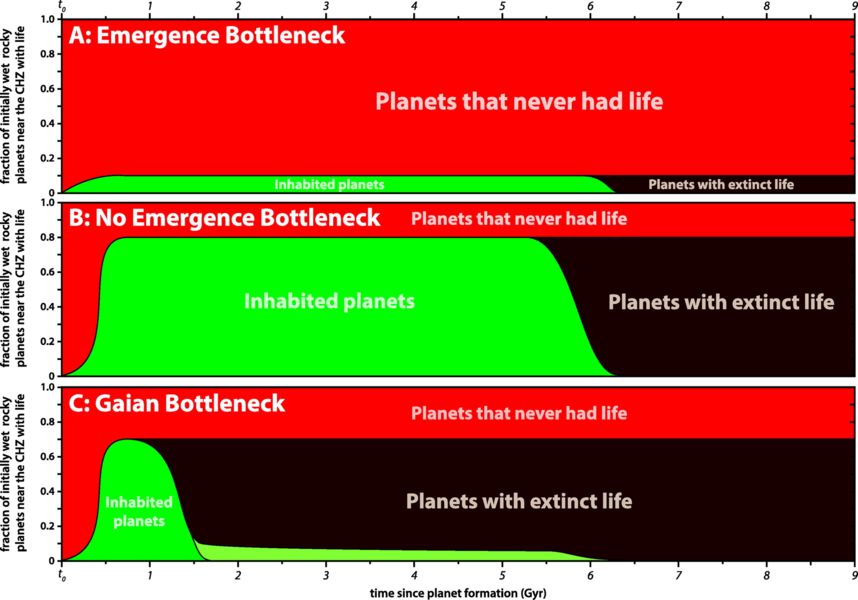
 02 Feb 2016: Does the Gaian bottleneck solve Fermi's paradox? 02 Feb 2016: Does the Gaian bottleneck solve Fermi's paradox?
 James Lovelock: essays, lectures and other writings James Lovelock: essays, lectures and other writings
 A redox-stratified ocean 3.2 billion years ago by Aaron M. Satkoski et al., doi:10.1016/j.epsl.2015.08.007, p 43-53 v 430, Earth and Planetary Science Letters, 15 Nov 2015; and commentary: A redox-stratified ocean 3.2 billion years ago by Aaron M. Satkoski et al., doi:10.1016/j.epsl.2015.08.007, p 43-53 v 430, Earth and Planetary Science Letters, 15 Nov 2015; and commentary:
 Ancient rocks record first evidence for photosynthesis that made oxygen by David Tenenbaum, University of Wisconsin-Madison (+SpaceDaily), 5 Oct 2015. Ancient rocks record first evidence for photosynthesis that made oxygen by David Tenenbaum, University of Wisconsin-Madison (+SpaceDaily), 5 Oct 2015.
 Eva E. Stüeken, Roger Buick, Bradley M. Guy and Matthew C. Koehler, "Isotopic evidence for biological nitrogen fixation by molybdenum-nitrogenase from 3.2 Gyr" [abstract], doi:10.1038/nature14180, p 666-669 v 520 Nature, 30 Apr 2015. Eva E. Stüeken, Roger Buick, Bradley M. Guy and Matthew C. Koehler, "Isotopic evidence for biological nitrogen fixation by molybdenum-nitrogenase from 3.2 Gyr" [abstract], doi:10.1038/nature14180, p 666-669 v 520 Nature, 30 Apr 2015.
 Katherine L. French et al., "Reappraisal of hydrocarbon biomarkers in Archean rocks" [abstract], doi:10.1073/pnas.1419563112, PNAS, 12 May 2015. Katherine L. French et al., "Reappraisal of hydrocarbon biomarkers in Archean rocks" [abstract], doi:10.1073/pnas.1419563112, PNAS, 12 May 2015.
 Carolyn Gramling, "Low oxygen stifled animals' emergence, study says" [abstract], doi:10.1126/science.346.6209.537, p 537 v 346, Science, 31 Oct 2014. Carolyn Gramling, "Low oxygen stifled animals' emergence, study says" [abstract], doi:10.1126/science.346.6209.537, p 537 v 346, Science, 31 Oct 2014.
 Lee R. Kump, "Hypothesized link between Neoproterozoic greening of the land surface and the establishment of an oxygen-rich atmosphere" [abstract], doi:10.1073/pnas.1321496111, Proc. Natl. Acad. Sci. USA, online 15 Sep 2014. Lee R. Kump, "Hypothesized link between Neoproterozoic greening of the land surface and the establishment of an oxygen-rich atmosphere" [abstract], doi:10.1073/pnas.1321496111, Proc. Natl. Acad. Sci. USA, online 15 Sep 2014.
 Sara Seager, "The future of spectroscopic life detection on exoplanets" [abstract], doi:10.1073/pnas.1304213111, Proc. Natl. Acad. Sci. USA, online 4 Aug 2014. Sara Seager, "The future of spectroscopic life detection on exoplanets" [abstract], doi:10.1073/pnas.1304213111, Proc. Natl. Acad. Sci. USA, online 4 Aug 2014.
 Oxygen fluctuations stalled life on Earth by Jane Qiu, Nature News, 11 Jul 2014. Oxygen fluctuations stalled life on Earth by Jane Qiu, Nature News, 11 Jul 2014.
 8 July 2014: Life has made Earth the way it is to a large extent. ...The Living Worlds hypothesis is simply extending the idea to other planets — David Grinspoon 8 July 2014: Life has made Earth the way it is to a large extent. ...The Living Worlds hypothesis is simply extending the idea to other planets — David Grinspoon
 23 Apr 2014: James Lovelock's latest book, A Rough Ride to the Future 23 Apr 2014: James Lovelock's latest book, A Rough Ride to the Future
 Daniel H. Rothman et al., "Methanogenic burst in the end-Permian carbon cycle" [abstract], doi:10.1073/pnas.1318106111, Proc. Natl. Acad. Sci. USA, online 31 Mar 2014; and commentary: Daniel H. Rothman et al., "Methanogenic burst in the end-Permian carbon cycle" [abstract], doi:10.1073/pnas.1318106111, Proc. Natl. Acad. Sci. USA, online 31 Mar 2014; and commentary:
 ...How gas-belching microbes could have caused mass extinction by Chelsea Wald, Nature News, 31 Mar 2013. ...How gas-belching microbes could have caused mass extinction by Chelsea Wald, Nature News, 31 Mar 2013.
 K. Maher and C. P. Chamberlain, "Hydrologic Regulation of Chemical Weathering and the Geologic Carbon Cycle" [abstract], doi:10.1126/science.1250770, Science, online 13 Mar 2014; and commentary by Richard A. Kerr, "How Earth Can Cool Without Plunging Into a Deep Freeze" [abstract], doi:10.1126/science.343.6176.1189, p 1189 v 343, Science, 14 Mar 2014. K. Maher and C. P. Chamberlain, "Hydrologic Regulation of Chemical Weathering and the Geologic Carbon Cycle" [abstract], doi:10.1126/science.1250770, Science, online 13 Mar 2014; and commentary by Richard A. Kerr, "How Earth Can Cool Without Plunging Into a Deep Freeze" [abstract], doi:10.1126/science.343.6176.1189, p 1189 v 343, Science, 14 Mar 2014.
 Donald E. Canfield, Oxygen: A Four Billion Year History, ISBN:9780691145020,
Princeton University Press, 2014. Donald E. Canfield, Oxygen: A Four Billion Year History, ISBN:9780691145020,
Princeton University Press, 2014.
 Ceridwen I. Fraser, Aleks Terauds et al., "Geothermal activity helps life survive glacial cycles" [abstract], doi:10.1073/pnas.1321437111, Proc. Natl. Acad. Sci. USA, online 10 Mar 2014. Ceridwen I. Fraser, Aleks Terauds et al., "Geothermal activity helps life survive glacial cycles" [abstract], doi:10.1073/pnas.1321437111, Proc. Natl. Acad. Sci. USA, online 10 Mar 2014.
 Timothy W. Lyons et al., "The rise of oxygen in Earth's early ocean and atmosphere" [html], doi:10.1038/nature13068, p 307-315 v 506, Nature, 20 Feb 2014. Timothy W. Lyons et al., "The rise of oxygen in Earth's early ocean and atmosphere" [html], doi:10.1038/nature13068, p 307-315 v 506, Nature, 20 Feb 2014.
 30 Nov 2013: Astrobiology: A Very Short Introduction — discusses Gaian processes. 30 Nov 2013: Astrobiology: A Very Short Introduction — discusses Gaian processes.
 Tricks of Ice-Seeding Bacteria, Astrobiology Magazine, 24 Oct 2013. Tricks of Ice-Seeding Bacteria, Astrobiology Magazine, 24 Oct 2013.
 A Stepping-Stone for Oxygen on Earth by Katie Neith, Caltech (+The Daily Galaxy), 26 Jun 2013. A Stepping-Stone for Oxygen on Earth by Katie Neith, Caltech (+The Daily Galaxy), 26 Jun 2013.
 Gaia's comeback: How life shapes the weather by Stephen Battersby, New Scientist, 1 Jul 2013. Gaia's comeback: How life shapes the weather by Stephen Battersby, New Scientist, 1 Jul 2013.

 21 Jun 2013: Mars had an oxygen-rich atmosphere long before Earth did.... 21 Jun 2013: Mars had an oxygen-rich atmosphere long before Earth did....
 Bettina E. Schirrmeister et al., "Evolution of multicellularity coincided with increased diversification of cyanobacteria and the Great Oxidation Event" [abstract], doi:10.1073/pnas.1209927110, p1791-1796 v110, Proc. Natl. Acad. Sci. USA, 29 Jan 2013. "Our results indicate an origin of cyanobacteria before the rise of atmospheric oxygen." Bettina E. Schirrmeister et al., "Evolution of multicellularity coincided with increased diversification of cyanobacteria and the Great Oxidation Event" [abstract], doi:10.1073/pnas.1209927110, p1791-1796 v110, Proc. Natl. Acad. Sci. USA, 29 Jan 2013. "Our results indicate an origin of cyanobacteria before the rise of atmospheric oxygen."
 Building blocks of life came from deep Earth by Tom Marshall, Planet Earth Online (+PhysOrg.com), 6 Aug 2012. Building blocks of life came from deep Earth by Tom Marshall, Planet Earth Online (+PhysOrg.com), 6 Aug 2012.
 You Owe Your Life to Rock by Sid Perkins, ScienceNow, 15 Jun 2012. You Owe Your Life to Rock by Sid Perkins, ScienceNow, 15 Jun 2012.
 Harry Oduro et al., "Sulfur isotope variability of oceanic DMSP generation and its contributions to marine biogenic sulfur emissions" [abstract], doi:10.1073/pnas.1117691109, Proc. Natl. Acad. Sci. USA, onine 14 May 2012. And commentary: Harry Oduro et al., "Sulfur isotope variability of oceanic DMSP generation and its contributions to marine biogenic sulfur emissions" [abstract], doi:10.1073/pnas.1117691109, Proc. Natl. Acad. Sci. USA, onine 14 May 2012. And commentary:
 UMD Finding May Hold Key to Gaia Theory of Earth as Living Organism, University of Maryland (+PhysOrg.com +ScienceDaily), 15 May 2012. UMD Finding May Hold Key to Gaia Theory of Earth as Living Organism, University of Maryland (+PhysOrg.com +ScienceDaily), 15 May 2012.
 Shanan E. Peters and Robert R. Gaines, "Formation of the 'Great Unconformity' as a trigger for the Cambrian explosion" [abstract], doi:10.1038/nature10969, p363-366 v484, Nature, 18 Apr 2012. Shanan E. Peters and Robert R. Gaines, "Formation of the 'Great Unconformity' as a trigger for the Cambrian explosion" [abstract], doi:10.1038/nature10969, p363-366 v484, Nature, 18 Apr 2012.
 Setting the Stage for Life: Scientists Make Key Discovery About the Atmosphere of Early Earth, The New York Center for Astrobiology at Rensselaer Polytechnic Institute, 30 Nov 2011. Setting the Stage for Life: Scientists Make Key Discovery About the Atmosphere of Early Earth, The New York Center for Astrobiology at Rensselaer Polytechnic Institute, 30 Nov 2011.
 29 Nov 2011: Lynn Margulis died on November 22nd. 29 Nov 2011: Lynn Margulis died on November 22nd.
 Bacteria helped early animals to breathe, doi:10.1038/news.2011.290, by Matt Kaplan, NatureNews, 15 May 2011. Bacteria helped early animals to breathe, doi:10.1038/news.2011.290, by Matt Kaplan, NatureNews, 15 May 2011.
 23 Jan 2011: Genes for using oxygen appeared... around 2.8 billion years ago, long before oxygen began accumulating.... 23 Jan 2011: Genes for using oxygen appeared... around 2.8 billion years ago, long before oxygen began accumulating....
 Donald E. Canfield et al., "The Evolution and Future of Earth's Nitrogen Cycle" [abstract], doi:10.1126/science.1186120, p192-196 v330, Science, 8 Oct 2010. Donald E. Canfield et al., "The Evolution and Future of Earth's Nitrogen Cycle" [abstract], doi:10.1126/science.1186120, p192-196 v330, Science, 8 Oct 2010.
 Did 'Snowball Earths' Trigger Animal Evolution? by Richard A. Kerr, ScienceNow, 27 Oct 2010. Did 'Snowball Earths' Trigger Animal Evolution? by Richard A. Kerr, ScienceNow, 27 Oct 2010.
 Plants set stage for evolutionary drama, doi:10.1038/news.2010.497, by Joseph Milton, Nature News, 27 Sep 2010. Plants set stage for evolutionary drama, doi:10.1038/news.2010.497, by Joseph Milton, Nature News, 27 Sep 2010.
 24 Sep 2010: "Seeking Signs of Life" is an upcoming symposium, 14 Oct, where James Lovelock is a keynote speaker. 24 Sep 2010: "Seeking Signs of Life" is an upcoming symposium, 14 Oct, where James Lovelock is a keynote speaker.
 Alien Climates Play Key Role in Possibility of Life by Clara Moskowitz, Astrobiology Magazine, 3 Jun 2010. Alien Climates Play Key Role in Possibility of Life by Clara Moskowitz, Astrobiology Magazine, 3 Jun 2010.
 E. T. Wolf and O. B. Toon, "Fractal Organic Hazes Provided an Ultraviolet Shield for Early Earth" [abstract], doi:10.1126/science.1183260, p1266-1268 / and commentary by Christopher F. Chyba, "Countering the Early Faint Sun" [abstract], doi:10.1126/science.1189196, p1238-1239 / v328, Science, 4 Jun 2010. E. T. Wolf and O. B. Toon, "Fractal Organic Hazes Provided an Ultraviolet Shield for Early Earth" [abstract], doi:10.1126/science.1183260, p1266-1268 / and commentary by Christopher F. Chyba, "Countering the Early Faint Sun" [abstract], doi:10.1126/science.1189196, p1238-1239 / v328, Science, 4 Jun 2010.
 Early Earth Haze Likely Provided Ultraviolet Shield for Planet..., University of Colorado at Boulder, 3 Jun 2010. "...A thick organic haze that enshrouded early Earth several billion years ago may have been similar to the haze now hovering above Saturn's largest moon, Titan, and would have protected primordial life on the planet from the damaging effects of ultraviolet radiation." Early Earth Haze Likely Provided Ultraviolet Shield for Planet..., University of Colorado at Boulder, 3 Jun 2010. "...A thick organic haze that enshrouded early Earth several billion years ago may have been similar to the haze now hovering above Saturn's largest moon, Titan, and would have protected primordial life on the planet from the damaging effects of ultraviolet radiation."
 Did Phosphorus Trigger Complex Evolution–and Blue Skies?, Carnegie Institution, 10 May 2010. Did Phosphorus Trigger Complex Evolution–and Blue Skies?, Carnegie Institution, 10 May 2010.
 19 Apr 2010: The extreme diversity and curious distribution of deep sea microbes are among the great mysteries of nature.... 19 Apr 2010: The extreme diversity and curious distribution of deep sea microbes are among the great mysteries of nature....
 Early Earth stayed warm because its ocean absorbed more sunlight...., Stanford University, 5 Apr 2010. Early Earth stayed warm because its ocean absorbed more sunlight...., Stanford University, 5 Apr 2010.
 Katharina F. Ettwig, Margaret K. Butler et al. "Nitrite-driven anaerobic methane oxidation by oxygenic bacteria" [abstract], doi:10.1038/nature08883, p543-548 v464, Nature, 25 Mar 2010. Katharina F. Ettwig, Margaret K. Butler et al. "Nitrite-driven anaerobic methane oxidation by oxygenic bacteria" [abstract], doi:10.1038/nature08883, p543-548 v464, Nature, 25 Mar 2010.
 Quirin Schiermeier, "Keeping the young Earth cosy" [html], doi:10.1038/news.2009.1086, Nature, online 15 Nov 2009. Quirin Schiermeier, "Keeping the young Earth cosy" [html], doi:10.1038/news.2009.1086, Nature, online 15 Nov 2009.
 D. T. Johnston et al., "Anoxygenic photosynthesis modulated Proterozoic oxygen and sustained Earth's middle age" [OA abstract], doi:10.1073/pnas.0909248106, Proc. Natl. Acad. Sci. USA, online 28 Sep 2009. D. T. Johnston et al., "Anoxygenic photosynthesis modulated Proterozoic oxygen and sustained Earth's middle age" [OA abstract], doi:10.1073/pnas.0909248106, Proc. Natl. Acad. Sci. USA, online 28 Sep 2009.
 21 Aug 2009: I find it fascinating that this prokaryotic symbiosis could so profoundly shape the evolution of life.... 21 Aug 2009: I find it fascinating that this prokaryotic symbiosis could so profoundly shape the evolution of life....
 The greenhouse gas that saved the world, University of Copenhagen, 18 Aug 2009. The greenhouse gas that saved the world, University of Copenhagen, 18 Aug 2009.
 L. Paul Knauth and Martin J. Kennedy, "The late Precambrian greening of the Earth" [first paragraph], doi:10.1038/nature08213, Nature; and commentary by Eric Hand, When Earth greened over, doi:10.1038/460161a, p 161 v 460, Nature, online 8 Jul 2009. L. Paul Knauth and Martin J. Kennedy, "The late Precambrian greening of the Earth" [first paragraph], doi:10.1038/nature08213, Nature; and commentary by Eric Hand, When Earth greened over, doi:10.1038/460161a, p 161 v 460, Nature, online 8 Jul 2009.
 King-Fai Li et al., "Atmospheric pressure as a natural climate regulator for a terrestrial planet with a biosphere" [abstract], doi:10.1073/pnas.0809436106, Proc. Natl. Acad. Sci. USA, online 1 Jun 2009; and commentary: Caltech scientists predict greater longevity for planets with life, Caltech, 11 Jun 2009. King-Fai Li et al., "Atmospheric pressure as a natural climate regulator for a terrestrial planet with a biosphere" [abstract], doi:10.1073/pnas.0809436106, Proc. Natl. Acad. Sci. USA, online 1 Jun 2009; and commentary: Caltech scientists predict greater longevity for planets with life, Caltech, 11 Jun 2009.
 Airborne dust and microbial matter appear to play large role in ice formation in clouds, National Science Foundation, 17 May 2009. Airborne dust and microbial matter appear to play large role in ice formation in clouds, National Science Foundation, 17 May 2009.
 22 April 2009: An interview with James Lovelock ...is available for free from Nature.com. 22 April 2009: An interview with James Lovelock ...is available for free from Nature.com.
 How Early Was Oxygen's Rise?, by Richard A. Kerr, ScienceNOW Daily News, 16 Apr 2009. How Early Was Oxygen's Rise?, by Richard A. Kerr, ScienceNOW Daily News, 16 Apr 2009.
 Deep-sea rocks point to early oxygen on Earth, EurekAlert!, 24 Mar 2009. Deep-sea rocks point to early oxygen on Earth, EurekAlert!, 24 Mar 2009.
 Oxygenated Oceans Go Way, Way Back, by Phil Berardelli, ScienceNOW Daily News, 16 Mar 2009. Oxygenated Oceans Go Way, Way Back, by Phil Berardelli, ScienceNOW Daily News, 16 Mar 2009.
 4 Mar 2009: James Lovelock's newest book, The Vanishing Face of Gaia 4 Mar 2009: James Lovelock's newest book, The Vanishing Face of Gaia
 3 Mar 2009: For microbes, it appears that almost all of their major evolution took place before we have any record of them..... 3 Mar 2009: For microbes, it appears that almost all of their major evolution took place before we have any record of them.....
 7 Jan 2009: Latent evolutionary potential was realized soon after environmental limitations were removed. 7 Jan 2009: Latent evolutionary potential was realized soon after environmental limitations were removed.
 20 Nov 2008: Life has a role in the origin of minerals according to geophysicist Robert Hazen. 20 Nov 2008: Life has a role in the origin of minerals according to geophysicist Robert Hazen.
 C. Scott et al., "Tracing the stepwise oxygenation of the Proterozoic ocean" [abstract | Editor's Summary], doi:10.1038/nature06811, p 456-459 v 452, Nature, 27 Mar 2008; and commentary: Low oxygen and molybdenum in ancient oceans delayed evolution of life by 2 billion years, EurekAlert.org, 26 Mar 2008. C. Scott et al., "Tracing the stepwise oxygenation of the Proterozoic ocean" [abstract | Editor's Summary], doi:10.1038/nature06811, p 456-459 v 452, Nature, 27 Mar 2008; and commentary: Low oxygen and molybdenum in ancient oceans delayed evolution of life by 2 billion years, EurekAlert.org, 26 Mar 2008.
 Two Oxygenation Events In Ancient Oceans Sparked Spread Of Complex Life, ScienceDaily.com, 26 Feb 2008. Two Oxygenation Events In Ancient Oceans Sparked Spread Of Complex Life, ScienceDaily.com, 26 Feb 2008.
 Matthew R. Saltzman et al., "Increased Carbon Isotopic Fractionation during the Late Cambrian SPICE Event and a Pulse of Atmospheric Oxygen" [conference abstract], p 24 v 39 n 6, Abstracts with Programs, Geological Society of America, 28-31 Oct 2007; and commentary: Origin of "Breathable" Atmosphere on Earth Found, Newswise.com, 28 Oct 2007. Matthew R. Saltzman et al., "Increased Carbon Isotopic Fractionation during the Late Cambrian SPICE Event and a Pulse of Atmospheric Oxygen" [conference abstract], p 24 v 39 n 6, Abstracts with Programs, Geological Society of America, 28-31 Oct 2007; and commentary: Origin of "Breathable" Atmosphere on Earth Found, Newswise.com, 28 Oct 2007.
 2 Feb 2007: Radar reveals methane lakes on Titan. 2 Feb 2007: Radar reveals methane lakes on Titan.
 Oxygen burst seen before the birth of complex life: Air to breathe may have spurred the evolution of large animals, by Narelle Towie, doi:10.1038/news061204-12, News@Nature.com, 8 Dec 2006. Oxygen burst seen before the birth of complex life: Air to breathe may have spurred the evolution of large animals, by Narelle Towie, doi:10.1038/news061204-12, News@Nature.com, 8 Dec 2006.
 Colin Goldblatt, Timothy M. Lenton and Andrew J. Watson, "Bistability of atmospheric oxygen and the Great Oxidation" [text], 10.1038/nature05169, p 683-686 v 443, Nature, 12 Oct 2006. Colin Goldblatt, Timothy M. Lenton and Andrew J. Watson, "Bistability of atmospheric oxygen and the Great Oxidation" [text], 10.1038/nature05169, p 683-686 v 443, Nature, 12 Oct 2006.
 John W. Grula, "Evolution of Photosynthesis and Biospheric Oxygenation Contingent Upon Nitrogen Fixation?" [abstract], 10.1017/S1473550405002776, p 251-257 v 4 (3&4), International Journal of Astrobiology, Oct 2005. John W. Grula, "Evolution of Photosynthesis and Biospheric Oxygenation Contingent Upon Nitrogen Fixation?" [abstract], 10.1017/S1473550405002776, p 251-257 v 4 (3&4), International Journal of Astrobiology, Oct 2005.
 Douglas G.Capone et al., "Follow the Nitrogen," 10.1126/science.1111863, p 708-709 v 312, Science, 5 May 2006. Douglas G.Capone et al., "Follow the Nitrogen," 10.1126/science.1111863, p 708-709 v 312, Science, 5 May 2006.
 20 Apr 2005: The only thing we know of that creates mixtures like that is biology — David Grinspoon, re: Titan. 20 Apr 2005: The only thing we know of that creates mixtures like that is biology — David Grinspoon, re: Titan.
 9 Apr 2006: Microbes produced methane on Earth 3.5 billion years ago. 9 Apr 2006: Microbes produced methane on Earth 3.5 billion years ago.
 Akiko Tomitani et al., "The evolutionary diversification of cyanobacteria: Molecular-phylogenetic and paleontological perspectives" [abstract], 10.1073/pnas.0600999103, Proc. Natl. Acad. Sci. USA, online 28 Mar 2006. "...We suggest that the clade of cyanobacteria marked by cell differentiation diverged once between 2,450 and 2,100 [million years ago]...." Akiko Tomitani et al., "The evolutionary diversification of cyanobacteria: Molecular-phylogenetic and paleontological perspectives" [abstract], 10.1073/pnas.0600999103, Proc. Natl. Acad. Sci. USA, online 28 Mar 2006. "...We suggest that the clade of cyanobacteria marked by cell differentiation diverged once between 2,450 and 2,100 [million years ago]...."
 Bacterial genes could put plants on Mars, by Kelly Young, NewScientist.com, 14 Oct 2005. Bacterial genes could put plants on Mars, by Kelly Young, NewScientist.com, 14 Oct 2005.
 Earth's Wobble Burps, Astrobiology Magazine, 17 Sep 2005. Earth's Wobble Burps, Astrobiology Magazine, 17 Sep 2005.
 Climate Model Links Higher Temperatures to Prehistoric Extinction, National Center for Atmospheric Research and the University Corporation for Atmospheric Research, 24 Aug 2005. Climate Model Links Higher Temperatures to Prehistoric Extinction, National Center for Atmospheric Research and the University Corporation for Atmospheric Research, 24 Aug 2005.
 Cosmic Dust Supports a Snowball Earth, by Richard A. Kerr, ScienceNow, 7 Apr 2005. Cosmic Dust Supports a Snowball Earth, by Richard A. Kerr, ScienceNow, 7 Apr 2005.
 ...Evolution as driving force in Earth's development, by Tony Fitzpatrick, Washington University in St. Louis, 2 Feb 2005. ...Evolution as driving force in Earth's development, by Tony Fitzpatrick, Washington University in St. Louis, 2 Feb 2005.
 2 Jan 2005: Gaia's History: The Living Earth from Space. 2 Jan 2005: Gaia's History: The Living Earth from Space.
 28 Oct 2004: Cassini flew by Titan. 28 Oct 2004: Cassini flew by Titan.
 28 Sep 2004: Nova explains the origin of life. 28 Sep 2004: Nova explains the origin of life.
 S. Blair Hedges, Jaime E. Blair, Maria Venturi and Jason L. Shoe, "A molecular timescale of eukaryote evolution and the rise of complex multicellular life" [abstract], v 4 BMC Evolutionary Biology, 28 Jan 2004. "Oxygen levels in the environment, and the ability of eukaryotes to extract energy from oxygen, as well as produce oxygen, were key factors in the rise of complex multicellular life." See also Oxygen triggered the evolution of complex life forms, EurekAlert!, 26 Jan 2004. S. Blair Hedges, Jaime E. Blair, Maria Venturi and Jason L. Shoe, "A molecular timescale of eukaryote evolution and the rise of complex multicellular life" [abstract], v 4 BMC Evolutionary Biology, 28 Jan 2004. "Oxygen levels in the environment, and the ability of eukaryotes to extract energy from oxygen, as well as produce oxygen, were key factors in the rise of complex multicellular life." See also Oxygen triggered the evolution of complex life forms, EurekAlert!, 26 Jan 2004.
 James Lovelock, "Gaia: The living Earth" [text], p769-770 v 426, Nature, 18 Dec 2003. James Lovelock, "Gaia: The living Earth" [text], p769-770 v 426, Nature, 18 Dec 2003.
 Utah's Redrock May Have Changed Global Climate, by Brenda Beitler, Department of Geology and Geophysics, University of Utah, 3 Dec 2003. Utah's Redrock May Have Changed Global Climate, by Brenda Beitler, Department of Geology and Geophysics, University of Utah, 3 Dec 2003.
 Lonely Planets and Rare Earths — interview with David Grinspoon, by Leslie Mullen, Astrobiology Magazine, 1 Dec 2003. "...Life has shaped the world we know." Lonely Planets and Rare Earths — interview with David Grinspoon, by Leslie Mullen, Astrobiology Magazine, 1 Dec 2003. "...Life has shaped the world we know."
 The Rise of Oxygen, by Lee J. Siegel, Astrobiology Magazine, 30 July 2003. The Rise of Oxygen, by Lee J. Siegel, Astrobiology Magazine, 30 July 2003.
 Australian shale tells tale of layered seas, by Alvin Powell, Harvard University Gazette, 17 July 2003. "...The initial rise in oxygen didn't bring us to modern levels." Australian shale tells tale of layered seas, by Alvin Powell, Harvard University Gazette, 17 July 2003. "...The initial rise in oxygen didn't bring us to modern levels."
 J. M. Melillo et al., "Soil Warming and Carbon-Cycle Feedbacks to the Climate System" [abstract], doi:10.1126/science.1074153, p 2173-2176 v 298, Science, 13 Dec 2002. J. M. Melillo et al., "Soil Warming and Carbon-Cycle Feedbacks to the Climate System" [abstract], doi:10.1126/science.1074153, p 2173-2176 v 298, Science, 13 Dec 2002.
 2002, November 2: Cyanobacteria may not be as old as we thought. 2002, November 2: Cyanobacteria may not be as old as we thought.
 2002, September 25: Bacteria in atmosphere of Venus? 2002, September 25: Bacteria in atmosphere of Venus?
 Tracking the Path of Green Slime re: cyanobacteria, by Leslie Mullen, Astrobiology Magazine, 28 Aug 2002. Tracking the Path of Green Slime re: cyanobacteria, by Leslie Mullen, Astrobiology Magazine, 28 Aug 2002.
 In Search of E.T.'s Breath, Science@NASA, 10 Jan 2002. In Search of E.T.'s Breath, Science@NASA, 10 Jan 2002.
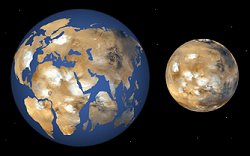 Earth and Mars have similar land areas Earth and Mars have similar land areas |
 Dust storm heats Mars by 30C, Science@NASA, 16 July 2001. Dust storm heats Mars by 30C, Science@NASA, 16 July 2001.
 2001, July 11: The moon, plate tectonics and life on Earth. 2001, July 11: The moon, plate tectonics and life on Earth.
 James Lovelock. Homage to Gaia: The Life of an Independent Scientist, Oxford University Press. 2000. James Lovelock. Homage to Gaia: The Life of an Independent Scientist, Oxford University Press. 2000.
 2001, January 29: NASA discusses "terraforming" Mars with bacteria. 2001, January 29: NASA discusses "terraforming" Mars with bacteria.
 "Father Earth," New Scientist magazine, 9 September 2000. "Father Earth," New Scientist magazine, 9 September 2000.
 2000, August 23: An interview with James Lovelock 2000, August 23: An interview with James Lovelock
 1999, December 3: Snowball Earth 1999, December 3: Snowball Earth
 1999, August 23: The Deep Hot Biosphere by Thomas Gold. 1999, August 23: The Deep Hot Biosphere by Thomas Gold.
 1999, April 29: Pictures of magnetic field reversals on Mars show that tectonic plates there have moved. 1999, April 29: Pictures of magnetic field reversals on Mars show that tectonic plates there have moved.
 1998, March 1: Distinguished scientists in London launch a new society promoting Gaia science. 1998, March 1: Distinguished scientists in London launch a new society promoting Gaia science.
References
1. James E. Lovelock, Gaia. Oxford: Oxford University Press 1979. p 143.
2. Lynn Margulis and Karlene V. Schwartz. Five Kingdoms, 2nd edition. W. H. Freeman and Company 1988. p 28.
3. Lynn Margulis and Dorion Sagan. What Is Life? Simon and Schuster 1995. p 83.
4. Christian de Duve, "The Birth of Complex Cells" p 50-57 Scientific American. April 1996.
5. James E. Lovelock, Gaia. Oxford: Oxford University Press 1979.
6. Richard A. Kerr, "Ice Bubbles Confirm Big Chill?" p 1584 v 272 Science. 14 June 1996.
7. Lynn Margulis and Dorion Sagan. What Is Life? Simon and Schuster 1995. p 83.
7.1. NASA's Astrobiology Workshop, 20-22 July 1998: Roadmap, Draft — 7 July 7 1998.
8. Steven Lee of University of Colorado and Philip James of The University of Toledo, Ohio, (cited in) "Telescope reporting space weather data." The Commercial Appeal (Memphis, Tennessee daily newspaper) 23 March 1995.
9. Kathy Sawyer, "Hubble Shows a Blue Face on Mars" p A03 The Washington Post. May 21, 1997.
10. James E. Lovelock, Gaia. Oxford: Oxford University Press 1979. chapter 6.
11. James E. Lovelock, The Ages of Gaia. W.W. Norton and Company 1988. p 105-112.
12. James E. Lovelock, Gaia. Oxford: Oxford University Press 1979. p 81.
13. Harry Y. McSween, Jr. Stardust to Planets. New York: St. Martin's Press 1993. p 194-196.
14. James E. Lovelock, The Ages of Gaia. W.W. Norton and Company 1988. p 104-5.
15. Thomas R. Worsley, R. Damian Nance, and Judith Moody. "Tectonics, Carbon, Life and Climate for the Last Three Billion Years: A Unified System?" p 200-210 Scientists on Gaia, Stephen H. Schneider and Penelope J. Boston, eds. The MIT Press 1991.
16. James Lovelock, 1996, personal communication.
17. James E. Lovelock, The Ages of Gaia. W.W. Norton and Company 1988.
Related Reading
 Michael H. Carr, Water on Mars. Oxford University Press, 1996. Michael H. Carr, Water on Mars. Oxford University Press, 1996.
 Timothy M. Lenton, "Gaia and natural selection" p 439-447 v 394 Nature, 30 Jul 1998. Timothy M. Lenton, "Gaia and natural selection" p 439-447 v 394 Nature, 30 Jul 1998.
 James E. Lovelock, "Hands up for the Gaia hypothesis" p 100-102 v 344 Nature, 8 Mar 1990. James E. Lovelock, "Hands up for the Gaia hypothesis" p 100-102 v 344 Nature, 8 Mar 1990.
 James E. Lovelock, Healing Gaia. Harmony Books, 1991. James E. Lovelock, Healing Gaia. Harmony Books, 1991.
 Oliver Morton, "Gaia: The veiled goddess" p 101-107, The Economist, 22 Dec 1990. Oliver Morton, "Gaia: The veiled goddess" p 101-107, The Economist, 22 Dec 1990.
 Jill Neimark, "A Conversation With Tyler Volk: Using Flows and Fluxes to Demythologize the Unity of Life," The New York Times, 11 Aug 1998. Jill Neimark, "A Conversation With Tyler Volk: Using Flows and Fluxes to Demythologize the Unity of Life," The New York Times, 11 Aug 1998.
 Fred Pearce, "Gaia, Gaia: don't go away" p 43-44 n 1927 v 142 New Scientist, 28 May 1994. Fred Pearce, "Gaia, Gaia: don't go away" p 43-44 n 1927 v 142 New Scientist, 28 May 1994.
 Stephen H. Schneider and Penelope J. Boston, eds., Scientists on Gaia (44 Articles), The MIT Press, 1991. Stephen H. Schneider and Penelope J. Boston, eds., Scientists on Gaia (44 Articles), The MIT Press, 1991.
 Tyler Volk, Gaia's Body: Toward a Physiology of Earth, Springer-Verlag New York, Inc., 1998. Tyler Volk, Gaia's Body: Toward a Physiology of Earth, Springer-Verlag New York, Inc., 1998.
 George Ronald Williams, The Molecular Biology of Gaia, Columbia University Press, 1996. George Ronald Williams, The Molecular Biology of Gaia, Columbia University Press, 1996.
![]()
|











